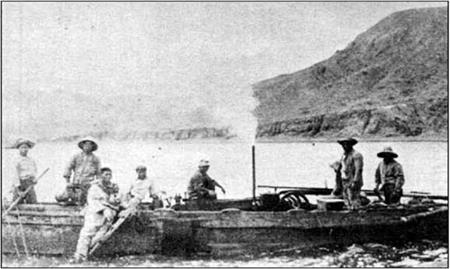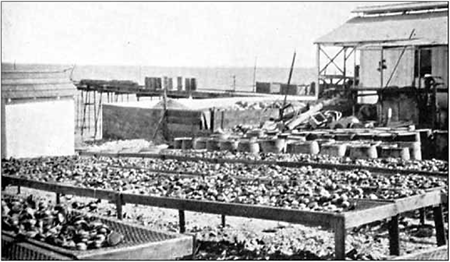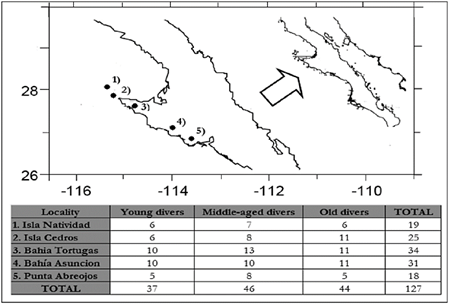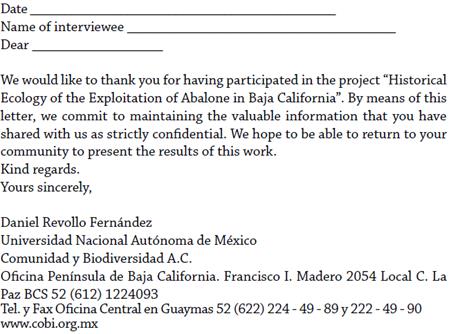On the coastline there are shells, originating from here, that are perhaps the finest in the world: their lustre, greater and more brilliant than that of the finest pearl, misted over and covered in an intense, pleasant blue cloudscape, as beautiful as that of lapis lazuli. This is like a very thin material. Or like a transparent superimposed varnish, through which the silvery bottom shines and stands out. It is said that if these shells were common in Europe, they would take away the value of pearls. Miguel del Barco (1706-1790)
Introduction
Marine resources have always played an important role in the history and development of Baja California, beginning with the arrival of the first hunter gatherers to the peninsula, who included seafood as a very important part of their diet, in particular as a source of protein (Erlandson, 1988). Very early reports and diaries of the main chroniclers and explorers that arrived to Baja California in the 16th and 17th centuries such as Francisco de Ulloa, Sebastián Vizcaíno, Francisco Javier Clavijero, Miguel Venegas, Eusebio Francisco Kino among others, notified the Spanish Crown about the great diversity and abundance of animals, especially marine animals, such as whales, sharks, otters, snappers, mantas, groupers, soles, lobsters and turtles (Quotation 1, 2 Annex 1).
The need of the Kings of Spain to conquer and expand their domain, as well as their interest as explorers in finding the desired Strait of Anian, led to the exploitation and trade of Baja California’s natural resources. At first, the fishing of shellfish such as abalone was mainly carried out by the aborigines and was for their own consumption. It was not until the mid 19th century that this type of fishing became a lucrative business due to its great demand on an international level (Ponce-Díaz, 2008). The first to exploit abalone commercially on the Baja Californian coasts were the Chinese, followed by the Japanese and finally the Mexicans.
Nowadays, abalone fishing has a high market value and is considered an activity in which many families and regions base both their economic and social activity (Ponce-Díaz et al., 1998). According to the Federation of Fishing Cooperatives (FEDECOOP), it generates more than 20,000 direct and indirect jobs. Currently it produces about 400 tons, the economic value of which ranks among the country’s fisheries with a value estimated at 81.4 million pesos, contributing 0.48 percent to the value of national fish production.
The catches reported over the last few years are little less than 15% of those reported in the 1950s. The hypotheses on the causes of this decrease are related to overfishing, marine climate changes, illegal and unregulated fishing or a combination of these factors (Ponce Díaz, 2008).
As the use of marine resources is a fundamental activity in an area surrounded on one side by the Pacific Ocean and on the other by the Sea of Cortez, or the Gulf of California, it is important to study the historical development of fishing. It is therefore necessary to study the history of the impact on marine populations and to determine the restoration objectives (Rogers-Bennett et al., 2002). However, these estimates are difficult to make due to the lack of or reliability of information expressed over a time series (Jackson et al., 2001).
This paper provides a review of the history of Baja California from prehistoric times up until present days and is based on the exploitation of abalone by Chinese and Japanese migrations and by the consolidation of Mexican Fishing Cooperatives. It also outlines the baseline abundances of abalone through oral history told by local fishermen.
Methods
During the summer of 2009 and spring 2010, we visited various historical archives and libraries in order to obtain information on the presence of abalone in Mexico’s history (The Federal District’s Historical Archive, the Library’s Reserve Collection and the National Newspaper Archive, the National Archive, the National Anthropology and History Institute’s Library).
During the same period, 127 active and/or retired abalone divers spanning three generations were interviewed from five fishing communities in Central Baja California (Figure 1). The three generations consisted of i) young divers (under 30 years old, N = 37), ii) middle-aged divers (between 31 and 44 years old, N = 46) and iii) older divers (over 45 years old, N = 44). The questionnaire was aimed at trying to understand their perception of the status of the abalone fishery (Annex 1 and 3). In the interview, they were asked about their best day’s catch, the largest number of abalones caught and the biggest abalone ever caught during their time working as abalone divers. These interviews were carried out in accordance with the method proposed by Sáenz-Arroyo et al. 2005. This oral information was used to get an idea of how the ecological perception of this shellfish has changed over time and was compared against the catch information, and both showed the same trend. Similarly, this information was used to quantify the potential number of eggs that are lost by reduction in weight and size through a function relating fecundity to the organism’s size (Shepherd et al., 1991).
Results
The first evidence of the use of abalone in California
Abalone is a benthic, univalve organism of primitive bilateral symmetry with a flat foot which it uses to move along the rocky sea beds, living in close contact with the kelp forest (Cox, 1962, Guzmán del Proo, 1989). Evidence of its existence goes back to found fossils dating from the Cretaceous period, 120 to 125 million years ago, showing little variation to its current form and structure (Cox ,1962).
Abalone has been a globally important resource. On Santa Rosa Island, near the State of Baja California, there are a great number of archaeological sites, which reveal the presence of humans for 10 to 13,000 years (Aguilar, 2002).
There was an order of preference in the exploitation and consumption of marine resources, starting with shellfish, fish, turtles and marine mammals, revealing a large number of middens along the entire peninsula. Also, it is important to note that the aborigines ate shellfish as a source of protein (Erlandson, 1988).
Discoveries and explorations on the coast of Baja California
At the beginning of the 16th century, several European countries became interested in exploring new lands to expand their territories and exploit natural resources. For example, Spain was looking for new sea routes to shorten the trip made by the Galeón de Manila (León-Portilla, 2001).
The first South Sea expedition made by Diego Hurtado de Mendoza and led by Hernán Cortes on 30 June 1532 was unsuccessful. The expeditions continued for many years, for example, those carried out by Cabeza de Vaca (1528-1536), Ulloa (1539-1540) and Rodríguez Cabrillo (1542-1543). As described by the Jesuit Father Miguel Venegas in 1739, Francisco de Ulloa’s expedition arrived as far as Isla de Cedros and Juan Rodríguez Cabrillo’s expedition reached Cabo Mendocino passing by Isla Natividad. The presence of abalone on the coasts of Isla de Cedros and Isla Natividad was conspicuous and often mentioned (Quotation 3, 4 Annex 1). The purpose of these explorations was to identify routes in the Pacific Ocean and to exploit the natural resources, mainly shellfish and pearls (del Portillo, 1982). In places where abalone or blue shells were found in abundance, it became the aborigines’ basic source of food and in some cases they used the shells for decorative purposes or currency (Cox, 1962) (Quotation 5 Annex 1).
In 1677, King Phillip II organized a new expedition to California; the Jesuits Eusebio Francisco Kino accompanied Isidro Atondo with the principal purpose of setting up a Mission. From San Bruno (first mission, 1683) several explorations were made, travelling as far as the Pacific Ocean at latitude of 26 degrees 7 minutes to a place they named Bahia de Año Nuevo. There, they found whale skeletons and some shells which were similar to the colours of the rainbow (Bolton et al., 2001) (Quotation 6 Annex 1).
Father Kino and Lieutenant Juan Mateo Mange made land explorations in California, which confirmed the existence of trade and communication between the aborigines from the coast and the inhabitants inland (Mange, 1792) (Quotation 7, 8, 9 Annex 1). Abalone shells, besides being considered ornaments or gifts, were used as currency among the aborigines (Sales, 1960). The currency used was called Uhl-lo and its value depended on the brilliance and size of the piece (Stearns, 1869 and 1887). For food, the indigenous people ate great quantities of shellfish on the same beaches, which they threw onto the fire to cook and then transported the shells to the mountains on long strings (del Barco et al., 1988) (Quotation 10, 11 Annex 1).
Until late 1690, it was not clear as to whether California was an island or a peninsula. An endless number of maps from that time show it in both ways (Kino, 1698 (1985)).
Father Eusebio Kino established several missions in the north of Sonora in Mexico and in the south of Arizona in the United States, where his attention was drawn to those blue shells that the indigenous people wore and that he had seen for the first time in the Bahía de Año Nuevo upon reaching the Pacific Ocean for the first time. His curiosity helped determine the origin of these shells by asking indigenous people from the upper Gulf of California and confirmed that California was not an island (Kino, 1698 (1985)) (Quotation 12, 13, 14 Annex 1).
The arrival of the Chinese and Japanese and finally the Mexicans dedicated to abalone fishing
Records indicate that the Chinese were the first to exploit this resource both in California and Baja California, starting their incursions in the decades that span from 1840 to 1860, with San Diego, California, US (Cox, 1962; Bonnot, 1948). In the case of abalone fishing in Baja California, records show that it was practised from Ensenada to Isla de Cedros (McEvoy ,1990) (Quotation 15 Annex 1).
In 1883, Mexico’s President Manuel González inspected the coast of Baja California in order to identify potential fishing. Noting that abalone fishing was done without any rules or regulations, they decided to extend the 1875 Act, which benefited companies with concessions. They believed that otherwise fishing would cause the extinction of species like abalone (Quotation 16, 17 Annex 1).
According to Velázquez-Morales (2007) the first information related to abalone fishing in the region was reported by the Subprefect of the Central Territory Party of Baja California in March 1879, denouncing the presence of a Chinese company fishing abalone on Isla de Cedros. Although the export of abalone meat and shells from San Francisco to China and Europe had started many years before, a large quantity of those exports also came from the coast of Baja California (Stearns, 1869). The poor technical ability that the Chinese had developed, the policy adopted by the United States to annul the Burlingame Treaty in Congress (1882) and the approval of a law prohibiting the entrance of Chinese workers for over a period of ten years, led this group to abandon fishing on the entire Pacific coast (McEvoy, 1990).
Subsequently, Japanese fishermen came to take the place of Chinese abalone fishers. As with the Chinese, the Mexican government signed an Amity and Commerce treaty with the Japanese in 1880. One of their activities was abalone fishing and they became known as the “sake barrel divers”, using the floating barrels as a fishing device enabling them to fish in places that were not close to the shore and prohibited by the government (Cox, 1962). It was these fishermen who introduced better technological advances for abalone fishing, with the introduction of diving suits which were used from 1920 until the end of the Second World War (Ortiz et al., 1988).
In 1908, Próspero and Aurelio Sandoval were granted the concession to trade in abalone for processing in the port of San Diego. This concession allowed inviting Japanese Kondo Masaharu to make several trips to interest him in exploiting the rich marine environment in Baja California (Velázquez-Morales, 2007) (Cota, 2009). Kondo Masaharu was born in Kyoto in 1877 and studied in the Imperial University of Tokyo, where he graduated in fishing and oceanography (Niiya, 1993).
In 1913, Kondo arrived to Bahía Magdalena. Using diving suits, they managed to collect large quantities of abalone in a very short time. Since there was an abundance of abalone, they started other camps in Isla Cedros and Bahía Tortugas (Figure 2). In order to send abalone meat to Asian countries through US ports, a drying method was followed using sea salts (Quotation 18 Annex 1). In addition, Kondo Masaharu managed to access European markets and sell abalone shells at higher prices than those obtained for meat (Estes, 1977) (Quotation 19 and 20 Annex 1). The quantity of abalone exported from Mexico to San Diego increased from 1.729 tons in 1923 to 3.400 tons in 1929 (Crocker, 1929) (Figure 3).

Figure 2 Japanese divers with diving gear, which was introduced by Kondo Masaharu, on Isla Cedros, Baja California (1910-1930) (Estes 1977)

Figure 3 Frames used for drying abalone - Isla Cedros B.C., Mexico (Croker, 1931. Photograph by Roger Chute 1926)
Kondo Masaharu’s profitable companies suffered a major blow with the onset of the global crisis of October 1929, lasting until the end of 1934. His canning company established in Bahia Tortugas was burned down in 1931. This caused Kondo to incur great financial losses, eventually the company became unsustainable and declared bankruptcy (Rivas-Córdova, 1999) (Quotation 21 Annex 1).
It is at the beginning of the 1930s, when various Mexican fishermen such as David and Francisco Espinoza, Donaciano Villalva among others, became involved in the capture and commercializtion of marine resources like abalone (Cota, 2009).
The cooperatives
The experience gained by some Mexican divers who had worked with Japanese fishermen strengthened the cooperative movement which Mexican born fishermen started, establishing cooperatives dedicated to abalone fishing such as “California de San Ignacio” (1939), “Ensenada” (1940) and “Pescadores Nacionales de Abulón” (1943). During the Second World War, the production of abalone remained at 1.000 tons, with little diving equipment and the catch being confined to a few coastal areas (León & Muciño, 1995).
In 1946 and 1947, the Mexican Government issued a series of guidelines to regulate abalone diving and authorized the abalone fishing cooperatives to allocate part of their product to Northern Baja California. It is towards the end of this decade when the highest catch rates for this shellfish in the waters of Baja California are produced, reaching its peak in 1950, with almost 6.000 tons. Most of the abalone production was canned in the new plant, called “Baja California”, which was established by Mr Ernesto Ruffo Sandoval and situated in Bahía Asunción (Lelevier et al., 1989). By 1958, the California Cooperative of San Ignacio was set up in Bahía Asunción B.C.S. (Ortíz, León & Muciño, 1988).
From 1956 to 1972, the cooperatives’ catches declined, stabilizing at 3.000 tons per year. It was in this period when i) new fishing cooperatives were established, totalling 14 cooperatives and 17 canning plants in 1958 and ii) the Mexican Government determined measures to regulate fishing such as the minimum catch size, a two month ban from 16 January to 15 March and made it compulsory to transport live abalone to the processing plant (León & Muciño, 1995). In 1957, the cooperatives had access to a new fishing method - diving with hooks - enabling the divers to have greater movement and improved their productive efficiency (Cox, 1962).
From 1974 to 1984, catches were reduced by over 400 tons per year due to lack of minimum catch size control, the two month ban, the greater effort made by fishermen to meet increased international demand, unregulated fishing and the presence of “El Niño”, which caused changes in abalone populations (1976-1977 and 1982-1983) (León & Muciño, 1995).
In the mid 1980s, the Mexican Government signed agreements to set up abalone seed producing laboratories in Eréndira B.C. and Bahía Tortugas B.C.S., which were operated by the Department of Fisheries and the Federation of Fishing Cooperatives “Baja California” F.C.L. These laboratories produced juvenile abalone, which were used to repopulate abalone banks in Baja California. In 1990, the first fishing quotas were implemented to put a maximum limit on catches and indirectly control the effort made by fishermen (León & Muciño, 1995) (Ramade-Villanueva et al., 1998).
Estimation of baseline abundances of abalone in Baja California by using oral history
Over the past few decades, ecosystem restoration has become an important scientific topic due to the advanced deterioration of the environment and species extinction (Myers & Worm, 2003). Assessing suitable historical baseline abundances is welcomed by marine researchers (Jackson et al., 2001; Dayton et al., 1998; Baum & Myers, 2004; Saénz-Arroyo, et al., 2005). A species is of great importance to the economy and over time its importance disappears without leaving a trace of what society did to try to find an answer to this “strange” absence. This is the case of the pearl oyster, shark, gulf grouper, and red abalone fisheries on the Baja California peninsular (Sáenz-Arroyo, 2008).
Studies on baseline estimates for abalone or other related species are few, to say the least. Through using historical catch information, Rogers-Bennett et al. (2002) managed to reconstruct baseline abundances for several species of abalone in California and compare them with the quantities of biomass that existed in that period, indicating that the main causes of the disappearance of some species, such as white and black abalone, are the overfishing in the past and natural phenomena. In other studies, the implementation of marine reserves or no-fishing areas was suggested as a restoration method.
Since abalone has been an important resource for several centuries in the history of Baja California, it is important to find out the baseline abundance in order to be able to create policies towards its restoration in the future. In the interview, and in accordance with the method proposed by Sáenz-Arroyo et al., 2005, the divers were asked about their best day’s catch, the highest number of abalones caught and the biggest abalone caught in the history of their career.
From all the divers interviewed, the younger generation of divers reports that on average their biggest catch of pink abalone is approximately 17cm (Figure 4). While the older divers’ averages catch size of the same species was approximately 19cm. Therefore, oral history shows an approximate 14% reduction in the average size of pink abalone.

Figure 4 Best catch size (cm) reported by the divers (by generation) in all the years that they have been fishing pink abalone (ANOVA, test, F=31.73, p<0.001) and green abalone (ANOVA, test, F=61.88, p<0.001)
There is a much bigger reduction in the case of green abalone. The older divers reported that in all the years that they have been fishing green abalone, their best catch size on average was approximately 25cm, while the young divers reported that the average size of their best catch is 19cm. This represents a reduction of almost 32%. Over time and from generation to generation, this information shows that on average smaller pink and green abalone are being fished.
The fact that the older divers have fished much larger and heavier pink and green abalone reflects that over time on average smaller abalones are being fished resulting in the reduction of the quantity of possible offspring. For example a 60cm long gray snapper produces ten times more offspring than one of 30cm (Pisco, 2008). For green abalone, the number of eggs produced is increased with the size of the body, as indicated in the following formula (Shepherd et al., 1991): f = 0.0026w - 0.61; where f is the number of eggs (millions) and w is the weight (g). Therefore, in the case of the young divers, the average abalone produces approximately 1.3million eggs, while in the older divers’ time the average abalone produced approximately 2.2million. So, over time, as reported by the divers, it can be seen that the offspring produced by green abalone has been reduced by 70%.
Discussion
Much of the history of California is characterized by the exploitation of its natural resources, many of which were poached, leading to their near extinction. This is the case of whales, pearl oysters, sharks, groupers, otters and abalone among others. From its beginning, abalone has always played an important role in Baja California’s economy and society, being used as a source of food, a unique gift, an offering at funerals and a means of payment as currency or for bartering. It was also recognized for its immeasurable beauty by various conquerors that arrived in these shores. Additionally, it helped Jesuit Father Eusebio Francisco Kino to clarify the confusion as to whether California was an island or a peninsula and find an overland route to facilitate trade.
Later, the Chinese and Japanese arrived to the coasts of Baja California and established the first industrial fisheries, exporting large quantities of abalone and other marine resources to Asia and Europe. This created a major negative impact on the quantity and quality of the species’ biomass and the techniques used caused great damage to the ecosystem, leaving no significant benefits to the area. Following the departure of the Japanese and Chinese, brought about by the protests of the Mexican citizens, but primarily because of the start of the Second World War, the Mexican fishermen took over the exploiting of the resources, increasing catch levels.
This loss of species and ecosystem deterioration has created the need to conduct studies on historical ecology and baseline abundance estimates as a first step in trying to restore the ecosystem, or as a reference point to be able to design the best policies, not only for the management of marine resources, but for all kinds of natural resources.
In the case of abalone in Baja California, the divers interviewed, confirmed that past generations obtained better catches in both weight (kilograms) and size (centimetres) as compared to what they fish today. This reduction in size and weight of abalones means that over time, their reproductive capacity has been affected, seen in the quantity of eggs that they stop producing. For green abalone, it is observed from the description of the divers from different generations that the offspring an abalone can produce has reduced by almost 70%. As a result, one might think that in addition to minimum catch sizes, maximum size should also be implemented to conserve the specimens that can produce more offspring. The large reduction in the reproductive potential of these organisms suggests that it is urgent to establish an additional measure to protect the reproductive banks by implementing a network of fully protected reserves. This would maintain and recover the populations in an ever-changing environment. Otherwise, the probability of the extinction of this species is alarmingly high. This first estimation is important for it can be used to observe the current situation of the population and determine what actions should be followed to preserve this resource.
Finally, it is important to point out that those magical realms full of gold and precious stones, so coveted by explorers, were discovered through the exploitation of natural resources in Baja California. We are living in these realms and it is everybody’s job to take care of them so that future generations can enjoy them and so that they do not become just a mythical legend.
Much of the history of California is characterized by the exploitation of its natural resources, many of which were poached, leading to their near extinction. This is the case of whales, pearl oysters, sharks, groupers, otters and abalone among others. From its beginning, abalone has always played an important role in Baja California’s economy and society, being used as a source of food, a unique gift, an offering at funerals and a means of payment as currency or for bartering











 nueva página del texto (beta)
nueva página del texto (beta)






